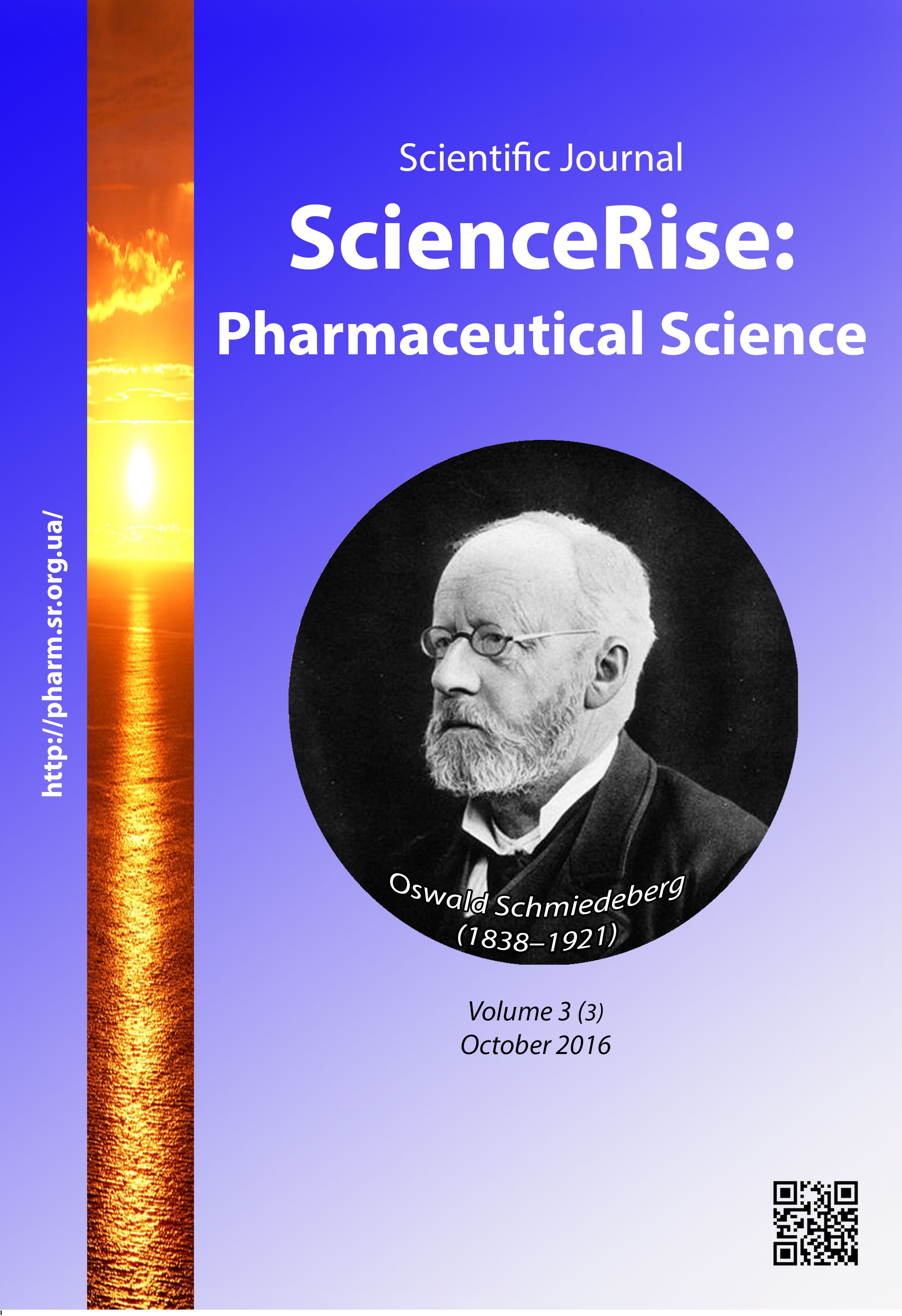Design of geriatric drug potentially increasing adiponectin expression
DOI:
https://doi.org/10.15587/2519-4852.2016.81471Keywords:
adiponectin, metabolic syndrome, insulin resistance, endotoxicity, exotoxicity, in silico, virtual screeningAbstract
Aim. The aim is to create in silico composition of the complex geriatric drug that is able to increase adiponectin expression in patients with symptoms of the metabolic syndrome.
Methods. The study was carried out by using in silico virtual screening with Prediction of Activity Spectra for Substances (PASS).
Results. The first phase of the study included 65 substances that were analyzed for the probability of ADIPOQ gene activation separately according to the protein and mRNA. The research allowed selecting the perspective APIs that are probable to increase expression of adiponectin with a maximum activity (Ra), namely active components of Valeriana officinalis L. extract – isovaleric acid, valeric acid, and γ-aminobutyric acid. Endo- and exotoxicity assessment revealed that the designed drug API have low toxicity.
Conclusion. Proposed composition of the geriatric drug increasing the expression of adiponectin (based on ADIPOQ gene activation), is perspective for further pharmacological, biopharmaceutical properties research and development of dosage forms
References
- Kosygina, A. V., Vasjukova, O. V. (2009). New in the pathogenesis ozhyreniya: adiponectin – a hormone of adipose tissue. Probl. Endokrinnoіpatologіі, 1, 44–50.
- Schwartz, B. (2009). Adipose tissue as an immune system organ. Cytokines and Inflammation, 4, 25–31.
- Roitberg, G. E. (Ed.) (2007). Metabolic Syndrome. Moscow: Medpress-inform, 224.
- Butrova, S. A. (2001). Metabolic syndrome: pathogenesis, clinical features, diagnosis, treatment approaches. Breast cancer, 2, 56–60.
- Arita, Y., Kihara, S., Ouchi, N., Takahashi, M., Maeda, K., Miyagawa, J. et. al. (1999). Paradoxical Decrease of an Adipose-Specific Protein, Adiponectin, in Obesity. Biochemical and Biophysical Research Communications, 257 (1), 79–83. doi: 10.1006/bbrc.1999.0255
- Pastors, J. G., Franz, M. J., Alexandria, V. A.; Franz, M. J., Evert, A. B. (Eds.) (2012). Effectiveness of medical nutrition therapy in diabetes. American Diabetes Association guide to nutrition therapy for diabetes. American Diabetes Association, 1–18.
- Hotta, K., Funahashi, T., Arita, Y., Takahashi, M., Matsuda, M., Okamoto, Y. et. al. (2000). Plasma Concentrations of a Novel, Adipose-Specific Protein, Adiponectin, in Type 2 Diabetic Patients. Arteriosclerosis, Thrombosis, and Vascular Biology, 20 (6), 1595–1599. doi: 10.1161/01.atv.20.6.1595
- Nishizawa, H., Shimomura, I., Kishida, K., Maeda, N., Kuriyama, H., Nagaretani, H. et. al. (2002). Androgens Decrease Plasma Adiponectin, an Insulin-Sensitizing Adipocyte-Derived Protein. Diabetes, 51 (9), 2734–2741. doi: 10.2337/diabetes.51.9.2734
- Weyer, C., Funahashi, T., Tanaka, S., Hotta, K., Matsuzawa, Y., Pratley, R. E., Tataranni, P. A. (2001). Hypoadiponectinemia in Obesity and Type 2 Diabetes: Close Association with Insulin Resistance and Hyperinsulinemia. The Journal of Clinical Endocrinology & Metabolism, 86 (5), 1930–1935. doi: 10.1210/jcem.86.5.7463
- Tanjanskij, D. A., Firova, Je. M., Shatilina, L. V., Denisenko, A. D. (2008). Adiponektin: snizhenie soderzhanija pri metabolicheskom sindrome i nezavisimaja svjaz' s gipertrigliceridemiej. Kardiologija, 12, 20–25.
- PubChem. Available at: http://pubchem.ncbi.nlm.nih.gov/
- Harris, R. (2003). Screening Adults for Type 2 Diabetes: A Review of the Evidence for the U.S. Preventive Services Task Force. Annals of Internal Medicine, 138 (3), 215. doi: 10.7326/0003-4819-138-3-200302040-00015
- Way2Drug. Available at: http://www.pharmaexpert.ru/PASSOnline/index.php
- Bessarabov, V. I., Zderko, N. P. (2013). Possible influenza efficacy of certain active pharmaceutical ingredients. Gerontologija, 1, 51–59.
- Bessarabov, V. I., Pal'chevskaja, T. A., Kuryshko, G. G., Kuz'mina, G. I., Tarasenko, A. V. (2014). Pharmaceutical analysis of complex geriatric drugs. Gerontologija, 2 (3), 338–344.
- Poroikov, V. V., Filimonov, D. A., Ihlenfeldt, W.-D., Gloriozova, T. A., Lagunin, A. A., Borodina, Y. V. (2003). PASS Biological Activity Spectrum Predictions in the Enhanced Open NCI Database Browser. Journal of Chemical Information and Computer Sciences, 43 (1), 228–236. doi: 10.1021/ci020048r
- Bessarabov, V. I., Palchevska, T. A., Kuzmina, G. І. (2015). Study in silico endo- and exo toxicity some biologically active substances from the extract of melissa officinalis l. Gerontologija, 3 (1), 96–107.
- Lagunin, A., Zakharov, A., Filimonov, D., Poroikov, V. (2011). QSAR Modelling of Rat Acute Toxicity on the Basis of PASS Prediction. Molecular Informatics, 30 (2-3), 241–250. doi: 10.1002/minf.201000151
Downloads
Published
How to Cite
Issue
Section
License
Copyright (c) 2016 Діана Іванівна Данилко, Володимир Іванович Бессарабов, Тетяна Андріївна Пальчевська

This work is licensed under a Creative Commons Attribution 4.0 International License.
Our journal abides by the Creative Commons CC BY copyright rights and permissions for open access journals.








